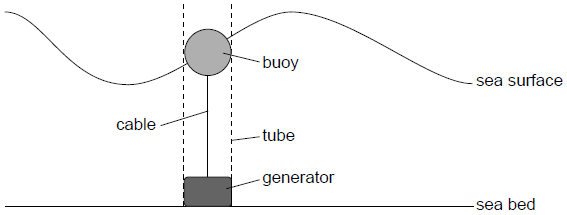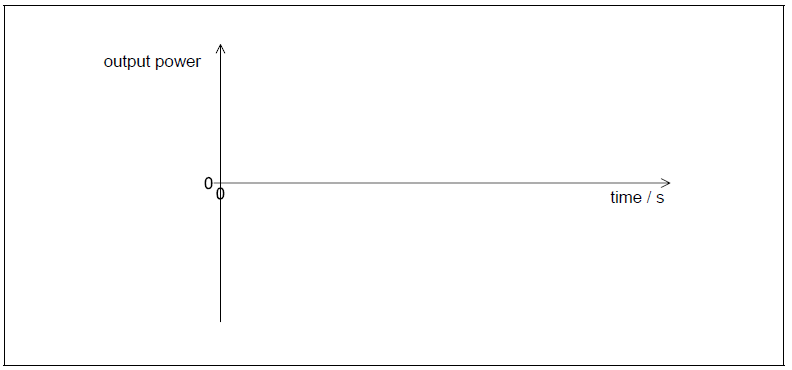IB PHYSICS HL(Higher level) – 2024 – Practice Questions- All Topics
Topic 8.1 Energy sources
Topic 8 Weightage : 3 %
All Questions for Topic 8.1 – Specific energy and energy density of fuel sources , Sankey diagrams , Primary energy sources , Electricity as a secondary and versatile form of energy , Renewable and non-renewable energy sources
A buoy, floating in a vertical tube, generates energy from the movement of water waves on the surface of the sea. When the buoy moves up, a cable turns a generator on the sea bed producing power. When the buoy moves down, the cable is wound in by a mechanism in the generator and no power is produced.

The motion of the buoy can be assumed to be simple harmonic.
Water can be used in other ways to generate energy.
a.
Outline the conditions necessary for simple harmonic motion (SHM) to occur.[2]
A wave of amplitude 4.3 m and wavelength 35 m, moves with a speed of 3.4 m s–1. Calculate the maximum vertical speed of the buoy.[3]
Sketch a graph to show the variation with time of the generator output power. Label the time axis with a suitable scale.
 [2]
[2]
Outline, with reference to energy changes, the operation of a pumped storage hydroelectric system.[2]
The water in a particular pumped storage hydroelectric system falls a vertical distance of 270 m to the turbines. Calculate the speed at which water arrives at the turbines. Assume that there is no energy loss in the system.[2]
The hydroelectric system has four 250 MW generators. Determine the maximum time for which the hydroelectric system can maintain full output when a mass of 1.5 x 1010 kg of water passes through the turbines.[2]
Not all the stored energy can be retrieved because of energy losses in the system. Explain two such losses.
 [2]
[2]
▶️Answer/Explanation
Markscheme
a.
force/acceleration proportional to displacement «from equilibrium position»
and directed towards equilibrium position/point
OR
and directed in opposite direction to the displacement from equilibrium position/point
Do not award marks for stating the defining equation for SHM.
Award [1 max] for a ω–=2x with a and x defined.
frequency of buoy movement \( = \frac{{3.4}}{{35}}\) or 0.097 «Hz»
OR
time period of buoy \( = \frac{{35}}{{3.4}}\) or 10.3 «s» or 10 «s»
v = «\(\frac{{2\pi {x_0}}}{T}\) or \(2\pi f{x_0}\)» \(\ = \frac{{2 \times \pi \times 4.3}}{{10.3}}\) or \(2 \times \pi \times 0.097 \times 4.3\)
2.6 «m s–1»
peaks separated by gaps equal to width of each pulse «shape of peak roughly as shown»
one cycle taking 10 s shown on graph

Judge by eye.
Do not accept cos2 or sin2 graph
At least two peaks needed.
Do not allow square waves or asymmetrical shapes.
Allow ECF from (b)(i) value of period if calculated.
PE of water is converted to KE of moving water/turbine to electrical energy «in generator/turbine/dynamo»
idea of pumped storage, ie: pump water back during night/when energy cheap to buy/when energy not in demand/when there is a surplus of energy
specific energy available = «gh =» 9.81 x 270 «= 2650J kg–1»
OR
mgh \( = \frac{1}{2}\)mv2
OR
v2 = 2gh
v = 73 «ms–1»
Do not allow 72 as round from 72.8
total energy = «mgh = 1.5 x 1010 x 9.81 x 270=» 4.0 x 1013 «J»
OR
total energy = «\(\frac{1}{2}m{v^2} = \frac{1}{2} \times 1.5 \times {10^{10}} \times \) (answer (c)(ii))2 =» 4.0 x 1013 «J»
time = «\(\frac{{4.0 \times {{10}^{13}}}}{{4 \times 2.5 \times {{10}^8}}}\)» 11.1h or 4.0 x 104 s
Use of 3.97 x 1013 «J» gives 11 h.
For MP2 the unit must be present.
friction/resistive losses in pipe/fluid resistance/turbulence/turbine or generator «bearings»
OR
sound energy losses from turbine/water in pipe
thermal energy/heat losses in wires/components
water requires kinetic energy to leave system so not all can be transferred
Must see “seat of friction” to award the mark.
Do not allow “friction” bald.
This question is about energy sources.
A small island is situated in the Arctic. The islanders require an electricity supply but have no fossil fuels on the island. It is suggested that wind generators should be used in combination with power stations using either oil or nuclear fuel.
a.Suggest the conditions that would make use of wind generators in combination with either oil or nuclear fuel suitable for the islanders.[3]
(i) Deduce the total energy, in GJ, generated by the wind generators in one year.
(ii) Explain why less energy can actually be generated by the wind generators than the value you deduced in (b)(i).[5]
▶️Answer/Explanation
Markscheme
a.
needs to be windy/high average wind speeds; space/land/room for wind turbines;
ability to import oil/nuclear fuel;
ability to dispose of nuclear waste;
comment relating to need for geological stability;
(i) π4.72 or 69.4 m2;
power = 15300 to 15400 W; 470 to 490 GJ;
(ii) wind must retain kinetic energy to escape or not all KE of wind can be converted to KE of blades;
energy lost to thermal energy (due to friction) in generator/turbine/dynamo;
turbine will suffer downtime when no wind/too much wind;
Allow any two relevant factors.
This question is about nuclear reactions.
A reaction that takes place in the core of a particular nuclear reactor is as shown.
\[_{\;92}^{235}{\text{U}} + {\text{X}} \to _{\;56}^{144}{\text{Ba}} + _{36}^{89}{\text{Kr}} + 3{\text{X}}\]
In the nuclear reactor, \(9.5 \times {10^{19}}\) fissions take place every second. Each fission gives rise to 200 MeV of energy that is available for conversion to electrical energy. The overall efficiency of the nuclear power station is 32%.
a.i.State the nature of X.[1]
▶️Answer/Explanation
Markscheme
a.i. neutron / \(_{\text{0}}^{\text{1}}{\text{n}}\);
mass of uranium atom \( = 235 \times 1.661 \times {10^{ – 27}}{\text{ }}( = 3.9 \times {10^{ – 25}}{\text{ kg}})\);
mass of uranium in one day \(( = 8.2 \times {10^{24}} \times 3.9 \times {10^{ – 25}}) = 3.2{\text{ kg}}\);
power output \( = (9.5 \times {10^{19}} \times 3.2 \times {10^{ – 11}} \times 0.32 = ){\text{ }}9.7 \times {10^8}{\text{ W}}\);
Award [1] for an answer of \(6.1 \times {10^{27}}{\text{ eV}}{{\text{s}}^{ – 1}}\).
because the probability of fission is (much) greater (with neutrons of thermal energy);
neutrons collide with/transfer energy to atoms/molecules (of the moderator);
of the coolant (and elsewhere);
(thermal energy) is converted into kinetic energy in moving steam;
(kinetic energy of steam) is transferred into (rotational) kinetic energy of turbine;
(kinetic energy of turbine) is transferred into electrical energy by dynamo/generator;